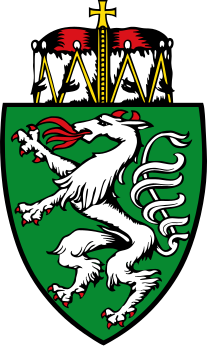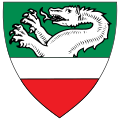
The Coat of arms of Styria (German: Steirisches Wappen) is the historic coat of arms of the region of Styria, a federal state of Austria. It shows a white heraldic panther (the 'Styrian Panther') with red horns and claws breathing red fire on a green field. The shield is crowned with the ducal hat of Styria. The coat of arms is also used in several municipal arms of the state, including Graz and Steyr.
The Styrian Panther
The panther, as the heraldic animal of Styria, was first used in the seal of Margrave Ottokar III in 1160. It was derived from the arms of the de:Traungau family. When Styria was made a duchy in 1180, the panther became the symbol of the entire duchy. The panther was originally black on a white field, but this was changed to the current color scheme in the 13th century in order to avoid confusion with Carantania, which at the time also used the black panther arms.
The coat of arms was first described in detail by the chronicler Ottokar of the Gaal, who documented around 1315 how the Styrian nobility fought alongside King Ottokar II of Bohemia in 1253 against the Hungarians under King Béla IV. Ottokar's state marshal, Herrand von Wildon described the flag as
"ein banier grüene als ein gras / darin ein pantel swebte / blanc, als ob ez lebte“ (a banner as green as grass / wherein a panther floated / white, as if it were alive)
In its current form, the coat of arms has been officially used since 1926 - in that year, the arms was modified to omit the flames that had previously emerged from all the panther's orifices (not only mouth and ears, but also from the phallus and anus). A member of the state parliament, Frida Mikula, sponsored the change due to the arms' apparent "obscenity".
The heraldic animal in its pre-1926 form can be seen today in the coat of arms of the Styrian capital, Graz.
Heraldic research today also points to the strong symbolic effect and the tradition of the Styrian coat of arms: “The Styrian heraldic animal has become a quasi-living symbol of Styrian independence. With the possible exception of the Tyrolean eagle, no coat of arms of the Austrian federal states can match it in terms of identity. The Styrian coat of arms has been in use in practically unchanged form for more than 750 years. Together with the red-white-red shield it is one of the oldest and most venerable state symbols in Europe."
Gallery
-
 The panther's earliest appearance on Ottokar III of Styria's seal, 1160
The panther's earliest appearance on Ottokar III of Styria's seal, 1160
-
 Ducal arms, 1445
Ducal arms, 1445
-
 Ducal arms, Hans Burgkmair, 1525
Ducal arms, Hans Burgkmair, 1525
-
 The arms in the Aula of the Palace of Justice, Vienna, circa 1880
The arms in the Aula of the Palace of Justice, Vienna, circa 1880
-
 The arms in a heraldic console decorated with edelweiss, Hugo Gerard Ströhl, 1890
The arms in a heraldic console decorated with edelweiss, Hugo Gerard Ströhl, 1890
-
 The current arms of Graz, showing the Panther in its pre-1926 state
The current arms of Graz, showing the Panther in its pre-1926 state
-
 On the arms of the eponymous city of Steyr
On the arms of the eponymous city of Steyr
-
 Enns
Enns
-
 Mödling
Mödling
-
 Kainbach bei Graz, showing a lion and a panther
Kainbach bei Graz, showing a lion and a panther
References
- Stummer, Verwaltung-Land Steiermark, Thomas. "Landeswappen Steiermark (The Coat of Arms of Styria)". www.verwaltung.steiermark.at (in German). Retrieved 2021-05-05.
{{cite web}}: CS1 maint: multiple names: authors list (link) - "Steiermark - Wappen - coat of arms - crest of Steiermark". www.heraldry-wiki.com. Retrieved 2021-05-06.
- "Styria (Austria)". www.crwflags.com. Retrieved 2021-05-06.
- ^ Diem, Peter (1995). Die Symbole Österreichs. Zeit und Geschichte in Zeichen. Vienna: Kremayr & Scheriau. pp. 340–344. ISBN 3-218-00594-9.
- Posse, Otto (1913). Die Siegel der Deutschen Kaiser und Könige. Dresden: Wilhelm und Bertha v. Baensch Stiftung.
- Werner, Matthias (2005). Spätmittelalterliches Landesbewusstsein in Deutschland. Ostfildern: Jan Thorbecke Verlag. p. 177. ISBN 3-7995-6861-1.